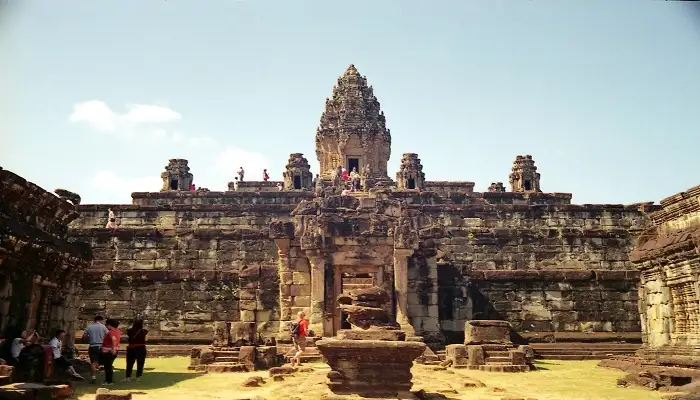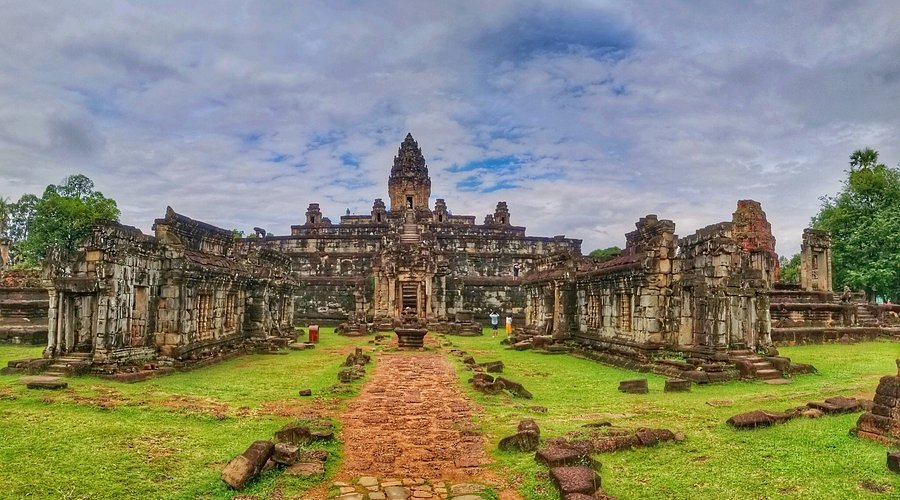Bakong Temple is a monumental treasure and one of the earliest and most influential temples in Cambodia’s Angkor region. Often overshadowed by its more famous neighbors, Bakong deserves recognition as the prototype of Khmer temple-mountains, laying the architectural foundation for masterpieces like Angkor Wat and Bayon.
Located in the Roluos Group, just southeast of Siem Reap, Bakong is both a historical landmark and a symbol of spiritual devotion—where the rise of the Khmer Empire truly began.

🗝️ Key Highlights
- The first large sandstone temple mountain built in the Angkor region
- Dedicated to the Hindu god Shiva and modeled after Mount Meru
- Built in the late 9th century by King Indravarman I
- Part of the Roluos Group, the ancient capital of Hariharalaya
- A peaceful site with fewer crowds and rich historical significance
🧱 Stepping into History: The Significance of Bakong Temple
Constructed in 881 AD during the reign of King Indravarman I, Bakong Temple was the state temple of the city of Hariharalaya, the capital before Angkor was established. This temple represents the first fully realized temple mountain, introducing architectural elements that would define Khmer art for centuries.
It was dedicated to Shiva, one of the principal deities in Hinduism, and built as a spiritual representation of Mount Meru, the center of the universe in Hindu cosmology.
🏛️ Temple Mountain Architecture at Its Genesis
Bakong is built in the form of a step pyramid, with five ascending tiers symbolizing the five peaks of Mount Meru. It is surrounded by a moat, a symbolic ocean, emphasizing the temple’s sacred nature and cosmic symbolism.
Key Features:
- A central sandstone pyramid rising in five levels, crowned by a sanctuary tower
- Eight smaller brick towers on the ground level
- Four corner shrines on the upper tiers
- A series of stone staircases leading to the summit
- Beautifully carved Nāga balustrades, lions, and guardian statues
Surrounding the central pyramid are several satellite temples and prasats (shrines), many built from brick and laterite, some with fine stucco decoration still visible.
🕉️ A Spiritual and Political Statement
Bakong was more than just a temple—it was a symbol of divine kingship. By building this temple mountain, King Indravarman I reinforced his legitimacy and divine right to rule. The elevation of the central sanctuary represented his connection to the heavens and the gods.
This concept of Devaraja (god-king) would become a cornerstone of Khmer ideology, echoed in later masterpieces like Angkor Wat.
🧭 The Roluos Group: Exploring Cambodia’s First Capital
Bakong is part of the Roluos Group, which also includes Preah Ko and Lolei—each representing different stages of early Khmer temple construction. These temples were part of Hariharalaya, the first major city of the Khmer Empire.
Why Visit the Roluos Group?
- Far fewer tourists compared to Angkor’s main circuit
- Serene surroundings and lush rice fields
- Excellent for photography, quiet reflection, and cultural immersion
- Offers insight into the origins of Angkorian architecture and engineering
🛡️ Restoration and Preservation
Bakong has been the subject of restoration efforts by the EFEO (École française d’Extrême-Orient) and Cambodian authorities. Its unique combination of brick, sandstone, and laterite construction required careful stabilization and conservation.
Visitors today can enjoy a well-preserved and easily accessible site that retains its original grandeur while offering a more peaceful and personal experience than the larger Angkor temples.
📍 Practical Information for Visitors
- Opening Hours: 7:30 AM – 5:30 PM
- Entrance Fee: Included in the Angkor Pass
- Distance from Siem Reap: 13 km southeast (approx. 25–30 minutes by tuk-tuk or car)
- Part of Tour: Often included in the Roluos Group or Grand Circuit tour
Visitor Tips:
- Combine Bakong with Preah Ko and Lolei for a complete Roluos Group experience
- Bring water, sunscreen, and a hat—there’s limited shade
- The upper tiers require climbing stone steps—wear good walking shoes
- Early morning or late afternoon offers the best light for photography and cooler temperatures
🙋♀️ Frequently Asked Questions (FAQ)
Is Bakong Temple worth visiting?
Absolutely. As the first major temple mountain, Bakong provides critical historical insight and a tranquil alternative to the more crowded temples.
Do I need a separate ticket for Bakong?
No. Bakong is covered by the standard Angkor Pass.
How long should I spend at Bakong?
1–1.5 hours is usually enough to explore the temple and surrounding structures at a relaxed pace.
Can I visit Bakong as part of a guided tour?
Yes, most guided tours to the Roluos Group include Bakong. Private and group options are available from Siem Reap.
Is Bakong family-friendly?
Yes, though younger children should be supervised when climbing the steep steps.
🌟 In Conclusion
Bakong Temple is where it all began—the architectural and spiritual prototype for centuries of Khmer temple design. Its peaceful setting, rich symbolism, and historical importance make it an essential stop for anyone who wants to truly understand the roots of Angkorian civilization.
Less crowded and deeply atmospheric, Bakong is a perfect destination for explorers, historians, and travelers in search of Cambodia’s cultural soul.
